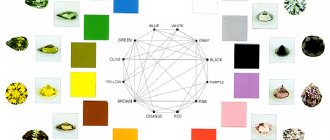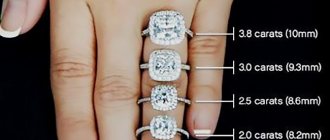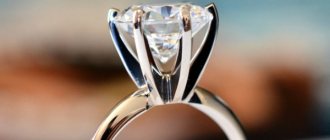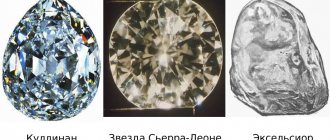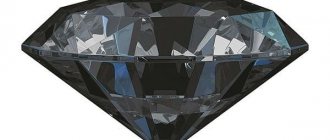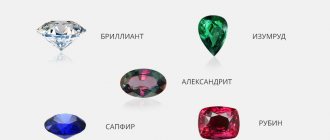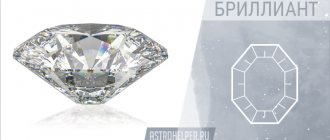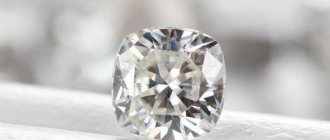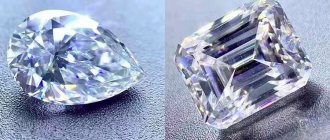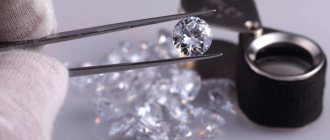It is impossible to determine the exact number of facets a diamond has, because their presence will be determined by the size and shape of the precious mineral.
A stone can have from 2 to 102 falsettos; a cut of 57 falsettos is considered classic, that is, a diamond has 57 facets and a circle shape. Such crystals are considered ideal because they have amazing brilliance. However, we should not forget about other processing methods.
A little history
A diamond is not distinguished by its brilliance and in this parameter is significantly inferior to a diamond. It is not surprising that until stones were learned to be processed, they were not in great demand.
The situation changed radically when one of the court jewelers came up with the idea of working a little with the diamond. He subjected it to processing, the master created only a few faces and presented the result of the work to the king. This happened in the 16th century, since then diamonds have become rare and expensive, they began to be perceived as a symbol of power and prosperity.
Initially, they used a rose-shaped cut: jewelers created only a few facets by polishing the diamond a little. However, this was enough for the stone to begin to sparkle.
Today, this form of processing is considered obsolete, but crystals are still cut in this way, since “rose” has two significant advantages: it is easy to perform and allows you to minimize costs.
During processing, the mineral loses from 35 to 70% of its original mass. If the stone is rare and expensive, then a complex cut can significantly reduce its weight - for this reason, a jeweler may use a rose-shaped cut.
Despite the fact that diamonds began to be processed a long time ago, jewelers did not immediately achieve significant success in this matter.
In 1919, mathematician Marcel Tolkowsky was able to calculate the ideal proportions of diamonds. It is worth noting that back in the 17th century there was a cut similar to diamond or classic, but this method of processing crystals was far from ideal.
Thanks to the calculations of Marcel Tolkowsky, it was possible to create a cut in which light entered the stone through the crown, it was refracted from the faces that were located below. As a result, the light began to play with rays, a “rainbow” was created. This was the so-called ideal cut of 57 falsettos, which is still used today.
Today, there are several forms of diamond processing; the cutting method largely depends on the size of the stone and the presence of defects in its structure.
Ideal Cut Ranges for Popular Diamond Shapes
Cut shape Table (Table) % Height (Depth) % Aspect ratio (Ratio)
| 62-69 | 63-74 | 1.00-1.05 |
| 53-64 | 57-62 | 1.36-1.50 |
| 62-70 | 61-67 | 1.20-1.31 |
| 61-68 | 61-67 | 1.00-1.05 or 1.20-1.25 |
| 62-70 | 61-67 | 1.39-1.50 |
Other processing methods
There are several ways to cut diamonds. To make a diamond beautiful and shiny, a jeweler can use:
- Step cut.
- Modified.
- Mixed.
The step cut is considered one of the oldest. Pebbles that have the shape of a rectangle, triangle and trapezoid are processed in this way. The edges of the crystal are located parallel to the girdle - this type of processing will help hide the defects of the diamond and emphasize the color of the stone and its transparency. Often used when working with fancy diamonds.
The next type of stone processing is quite good; it helps to create high-quality diamonds; in terms of characteristics (transparency and brilliance), they can be on par with those crystals that have 57 falsettoes. A modified cut allows you to modify the stone and give it different shapes. At the same time, it is possible to maintain the number of faces and their location.
The mixed type of processing has a number of advantages: it helps to reduce costs during the work process, as well as add shine to the stone. Jewelers claim that this type of processing combines the advantages of step and diamond cutting. Such stones are currently in demand. For the first time, a mineral processed in this way was presented to the public in the 60s of the 19th century.
There is also an emerald cut. It allows you to visually increase the size of the stone. However, crystals are rarely processed in this way; they have the shape of a rectangle or square.
There is also “Russian cut” - this term originated during the USSR, but is still used today. The jewelers of the Soviet Union never came up with anything new, for this reason the term remained as a brand.
In the second half of the 20th century, jewelers created more sophisticated methods for processing diamonds. They are mainly used for cutting large diamonds weighing more than 1 carat:
- “Highlight-Cat” implies the creation of 73 falsettos, with 41 edges located on top and 32 below.
- “Royal cut” has 86 facets, with 49 facets located at the top and 37 at the bottom.
- A “majestic cut” of 102 falsettos implies the presence of 61 facets at the top and 41 at the bottom.
When evaluating a diamond, jewelers use the “4 C” system - it allows you to fully characterize the stone and determine its value. Cut is also taken into account when assessing the quality of a crystal.
This concept is considered subjective, since it can affect the cost of the mineral, but when evaluating a stone, not only the processing method, but also other criteria are taken into account.
There are several forms of processing that are considered common and occur quite often, among them are:
- "Marquis" with 55 falsettos.
- "Emerald" with 65 facets.
- "Oval" with 57 falsettos.
- "Triangle" with 52 sides.
- "Heart" with 57 falsettos.
- "Square" with 33 sides.
- "Baguette" with 25 and 33 falsettos.
All these processing methods are called fantasy; they are less common. The “baguette” is considered unique and is worth considering in more detail. “Baguette” is used when working with small diamonds. The quality of processing is checked in accordance with compliance with several criteria: determination of proportion and quality of symmetry.
In the classic variation, the diamond has 57 facets and a circle shape. But crystals of a different shape with fewer facets cannot be called less beautiful, since they also sparkle spectacularly in the sun and cause envy among others.
How many facets does a diamond have?
It all depends on the original stone sample, the cut and the imagination of the jeweler.
Nowadays it is customary to make 57 faces. This is considered the most common form, since this is the amount that allows you to optimally distribute the play of light on the diamond and, if necessary, remove flaws.
There are other known ways to process a diamond to give it different and interesting shapes:
- “Princess”, which has 65 facets;
- “Heart”, which has 57 facets;
- “Oval”, which has 57 facets;
- “Marquis”, which has 55 facets;
- “Pear”, which has 56 facets;
- “Triangle”, which has 52 facets;
- “Square”, which has 17 facets;
- “Rectangle”, which has 33 facets;
- “Cross”, which has 46 facets (the newest form of cutting from the Japanese master).
How many facets can there be?
We already know that facets are edges beveled at different angles that add beauty and magnificent play to a diamond. A turning point for jewelry makers was the mid-20th century. New cutting forms began to appear. The rapid development of technology has made it possible to create special tools with specific properties that allow for even better cutting and an increase in the number of facets (especially for large stones).
There is no point in listing all the new available varieties; it is enough to describe the most basic ones:
- the cut called “Majestic” contains 102 facets;
- the cut, called “Royal”, contains 86 facets;
- a cut called “High Light” contains 73 facets;
- and other types.
About fakes
Attempts to create an artificial diamond began in 1797, but they were crowned with success only in 1956. Over the decades, technology has improved so much that it can be difficult to distinguish an artificial stone from an original one. Some imitation diamonds are so beautifully crafted that only those who know what a real diamond looks like can tell the difference between them and the original.
The most common “fake” is called cubic zirconia. The second stone that imitates a crystal of natural origin is moissanite, which can only be distinguished by those who know how to verify its authenticity. The third option is asha. What gives it its shine is a layer of carbon atoms, that is, what a real stone is made of, which makes identification by eye a difficult task.
Growing artificial diamonds using high temperatures and pressure, invented in the 1950s, produces almost natural crystals. This is explained by the fact that natural stones appear under similar conditions, but over a longer period.
Pebbles that do not have time to go through the full growth cycle when they hit the earth's surface require additional exposure to temperature and pressure in laboratory conditions. This allows them to become full-fledged diamonds, slightly “modified” by humans. After additional procedures, they become completely ready to be turned into a diamond.
Fashion for raw stones
Contemporary jewelry art is characterized by a desire for individuality and uniqueness. Style, design, materials must correspond to the internal content of the individual. For this, it seems, it is not enough to simply enhance the product with an expensive diamond or use precious metals. It is important to find the most favorable combination of materials and shapes. Today's technologies make it possible to bring any design ideas to life, so rough diamonds are becoming more and more common in finished jewelry masterpieces.
The increased interest in raw gemstones is also due to the fact that they are more accessible to jewelers and individual artisans who sell their products online. The ideal of such beautiful products is natural beauty, which breaks through unpredictable colors and rough natural forms. The geometric perfection of shiny edges, playing with a richness of bright colors, fades into the background. The main thing is the originality of the original stones, filled with precious contents. Such materials personify the naturalness of female beauty. It is the nuggets of femininity that are valued most highly in any society.
Authentication
Sometimes the question arises about how to check a diamond for authenticity. After all, its high cost is an excellent reason for creating fakes and various imitations passed off as a real crystal. You can do this with the help of a specialist or yourself, at home.
How to determine the authenticity of a diamond:
- According to rudinist - a narrow boundary dividing a faceted crystal into upper and lower parts. It should be matte. Transparency indicates artificial origin.
- Hardness. Real diamond leaves marks on glass surfaces. It also scratches other minerals such as sapphires and rubies. The only exception to this method is moissanite, which has a hardness similar to diamond.
- Glitter and refraction of light. A real diamond sparkles, but not as much as moissanite. A natural crystal differs from fiant and zircon in its light refractive index: if you place the stones on a printed text, for example, a page of a book, you will not be able to see the letters through the original.
- Defects and inclusions. They are present in real stones and are absent in fakes, but in no case are they cracks on the surface, scratches or chips. What is diamond clarity →
- Light scattering and ultraviolet. A beam of light directed through a fake will remain just as intense. A real diamond glows under ultraviolet light.
- Marker drawing. A line drawn with a felt-tip pen or marker on the surface of a gemstone will be clear and even, whereas on a fake it will be blurry.
- Exposure to acids. Submerged in an acidic solution, a real diamond will endure the test with dignity, emerging unharmed.
- Indelible. It is difficult to erase a real stone, so you will have to examine the edges of the stone that has raised doubts. If they are smoothed out and appear erased, it is a fake.
Diamond rightly deserves the title of a unique and irreplaceable stone in the industry. At different times it was used for various purposes, but only when it gained jewelry interest did it become truly expensive. Its cost depends on the processing method, shape and changeability of fashion, but demand always remains high and is unlikely to ever change.
Sources
- https://zolotoe-runo-sl.ru/dragocennye-kamni/57-granej.html
- https://Brilliant24.ru/standarts/idealnaya-ogranka
- https://stone-stream.ru/interesnoe/ogranennyj-almaz.html
- https://obninsk-torg.ru/tehniki/br-kr-57.html
- https://PulsKamnya.ru/dragotsennie/almazy-i-brillianty/neogranennye
- https://velestone.ru/ukrasheniya/neogranennyj-almaz/
- https://zen.yandex.ru/media/gemstones/rojdenie-ogranki-brillianta-5cb2ffe06749e800b419fdcb
- https://PulsKamnya.ru/dragotsennie/almazy-i-brillianty/vidy-ogranki
- https://kamen.expert/dragotsennye-kamni/almaz-neogranennyj
Main cutting stages
The process of turning rough diamonds into polished diamonds is complex and responsible. The value of a stone is determined not only by its size, carat, color and clarity, but also by the type of cut and the work of the master jeweler. Mathematical precision is required for the crystal to sparkle with all its faces, reflecting the light falling on it.
The time it takes to process one crystal depends on:
- depending on the chosen shape - the more faces, the longer the process takes;
- size of the mineral - large ones take longer to cut, but there are small specimens that are valued more expensive than large ones due to painstaking and lengthy labor;
- the condition and newness of the equipment - the more modern it is, the faster things go;
- experience of the master - beginners are afraid to spoil the future diamond with an unnecessary movement of the hand.
The Golden Jubilee Diamond, which has 102 facets, was presented to the monarch of Thailand. It took 2 years to create it. Such instances are rare; work is usually carried out as usual. Average cutting time:
- preparation for cutting – 3–4 hours;
- sawing – a 1 carat stone needs to be sawed for 6–8 hours;
- grinding – 3–4 hours;
- polishing – 1–2 hours.
It turns out that it takes from 13 to 24 hours of continuous labor to create one diamond, which is 2-3 working days.
STAGE No. 1. Study of diamond crystals
Now cutters are helped by computer systems for modeling the proportions of the future diamond. The system evaluates the diamond and immediately gives a forecast for the optimal option for marking, sawing (if necessary) and cutting the diamond.
With the right technological process, one diamond crystal can produce two Kr-57 cut diamonds of different weights. Articles are published every day after 18:00 Moscow time. From one diamond crystal, with the right technological process, two Kr-57 cut diamonds of different weights can be obtained. Articles are published every day after 18:00 Moscow time.
At this stage, it is important to identify defective or “stressed” diamond crystals that may crumble later if not performed correctly. It is also important to know preliminary data on the weight of the future diamond (carat) and its projected cost.
STAGE No. 2. Marking and sawing
One of the key stages in the birth of a diamond.
Remember how for a year the jeweler thought about how to split the Cullinan diamond (the largest in the world, 3100 carats, found in Africa in 1905). As a result, having made one single blow on the diamond, the jeweler fainted from overexertion. When I woke up, I realized that I had done everything right. 8 large pieces and thousands of small ones appeared. The largest parts are inlaid into the scepter and crowns of the British Empire.
When marking, lines are drawn onto the diamond that form the future cutting plane. Sawing itself eliminates rough diamond defects or pronounced large inclusions, which greatly increases the cost.
STAGE No. 3. Rough peeling and turning
Rough stripping
- this is the removal of excess mass of the crystal. That mass that is not useful for cutting at all.
The result is a so-called “semi-finished product” that can be used for turning and cutting.
Turning
— creating a preliminary form of the future diamond. Whether it is possible to start applying edges to the diamond will depend on how well the turning is done. If not, continue to grind the stone again.
STAGE No. 4. Cutting and polishing
A diamond is graded using the 4C system: weight, color, clarity (inclusions) and cut quality. If the quality of the cut is poor, the diamond can lose up to 40% in its final value.
Diamond fettling (application of edges).Diamond fettling (application of edges).
This is why the cutting and polishing stage causes additional concern for any technologist. Especially when it comes to future diamonds weighing more than 1 carat and excellent characteristics.
Facets (facets) are obtained by rubbing the diamond in the right place on a grinding disc. To soften, use linseed or other oil.
First, the platform (the topmost face) is applied, then the edges of the pavilion (the bottom of the stone), then the edges of the crown (the top of the stone to the platform). At the very end, small edges of the girdle (the belt separating the top and bottom of the stone) are applied. Polishing is done on the same grinding disc, but with a finer diamond surface.
The main difficulty is to maintain the correct angles so that Tolkowsky’s mathematical formula begins to work and the diamond truly sparkles.
STEP No. 5. Washing and evaluation
Diamonds are not washed with just water. This is a “nuclear” mixture for eliminating all industrial dirt - concentrated sulfuric acid with potassium nitrate, then distilled water, and then pure alcohol.
Evaluation of the characteristics of the resulting diamond by gemologists. Evaluation of the characteristics of the resulting diamond by gemologists.
The assessment is carried out by gemologists, determining the characteristics of the stones (weight, color, clarity, quality of cut), and their cost.
Despite the use of technology and computer modeling, much remains on the conscience and talent of the cutter himself. This is especially true for stones of unique sizes and non-standard cut shapes. There are only a couple of hundred such cutters in the world.
